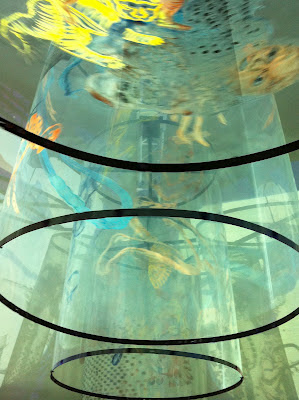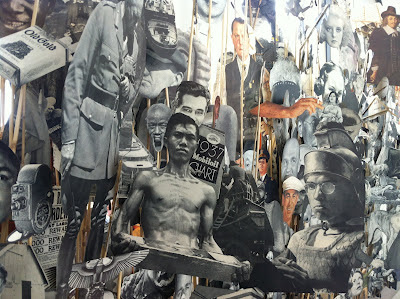While the world waits with bated breath for the 2012 Olympics is London, my interest lies across the Channel in a little city of Kassel, Germany. Every 5 years, the art world gather here to celebrate the dOCUMENTA, one of the most important art exhibitions in the world that showcases the latest in modern and contemporary art.
For 100 days (June 9 – September 16) over 150 artists present a wide spectrum of contemporary art, paintings, photographs, sculptures, videos, performance art, etc, from 55 countries. It’s a spectacular event that turns much of this industrial town into (literally) a walking museum, and there are displays of art works and exhibits throughout the center of the city, including the Orangerie.
Documenta is not one of these art shows that focus on marketing and sales. It’s not about finding “art work” to display in the new office building or that goes with your livingroom sofa. There are no glitz and glam, and most of the exhibits displayed are true reflections and interactions of the world around us. It’s definitely art for art's sake.
For almost 60 years, it has remained true to intentions of the original curator Arnold Bode, discovering and celebrating modern art, which was banished and repressed during the cultural darkness of Nazism, and it continues to enlighten and enrich the world with its own unique voice.
Again and again, the Documenta has shattered the world of art, whether in poor postwar times when people thirsted for art, whether in rebellious years of revolution, whether in the lighthearted era at the end of the 20th century or whether at the turn of the century dominated by globalization. The history of the Documenta is a history of defeats, of doubts, of scandals and, at the same time, of renewal, of discovery and of artistic creativity. Above all, however, it has always been a history of success.
– Michael Glasmeier and Karin Stengel
This year’s Documenta focusing on the trauma of war consists of more than 300 participants. There are also an extensive program of lectures, seminars, congresses, films, and poetry readings, as well as a writers’ residency and programs initiated by dOCUMENTA (13) participants.
Trying to see the entire exhibition in few days was overwhelming; however, I wouldn’t miss it for the world. I have visited Kassel to see Documenta for the past 15 years, and every time, I leave with new knowledge and new perspective of the world.
 |  |
 |  |
 |  |
Civilizations are not remembered by their bankers, lawyers or business people; they’re remembered by the arts. - Eli Broad
Notable Artists:
- Amar Kanwar – New Delhi based artist, whose films and installations are multi-layered, contemporary experiences connecting intimate personal histories with the wider politics of power, violence, sexuality, and justice. Kanwar’s meditative film essays do not aim to represent trauma or political situations as much as to find ways through them to a more contemplative space. Characterized by a distinctly poetic approach to the social and political, Kanwar’s work has been presented in several film festivals and museums.
- Etel Adnan – Lebanese-American writer and artist, a grande dame of Middle Eastern literature, a collector of worlds and languages.
- Geoffrey Farmer – Vancouverite has made a well-earned international name for himself by turning Arte Povera materials, like brooms, mops, Post-its and ripped-out book pages, into rich meditations on the biggest of the big themes: history, psychology, philosophy and the like. (Leaves of Grass)
- Maria Thereza Alves – “ Return of a Lake” traces the history of struggles around the Lake Chalco in Mexico City. The lake, a testimony to the country's problematic colonial history, has been drained of almost all its water and groundwater supplies, leaving the local community in the Xico region facing an environmental disaster.
- Nalini Malani – Her works are influenced by her experiences as a refugee of the Partition of India. She places inherited iconographies and cherished cultural stereotypes under pressure. Her point of view is unwaveringly urban and internationalist, and unsparing in its condemnation of a cynical nationalism that exploits the beliefs of the masses. Hers is an art of excess, going beyond the boundaries of legitimized narrative, exceeding the conventional and initiating dialogue. Characteristics of her work have been the gradual movement towards new media, international collaboration and expanding dimensions of the pictorial surface into the surrounding space as ephemeral wall drawing, installation, shadow play, multi projection works and theatre.
- Claire Pentacoste – Chicago based artist with projects focusing on the state of interconnectedness that we call “nature,” and the state of disconnection in the current definition of “knowledge.”
- Rahraw Omarzad – His works include photography, painting, performance and film. His photographs of children in Kabul are reminiscent of both Italian Neo-realism and films by Abbas Kiarostami. He is committed to healing the local art scene traumatized by recent armed conflicts.
- Sanja Iveković – A Croatian photographer, sculptor and installation artist, Iveković produced works of cross-cultural resonance that range from conceptual photomontages to video and performance.
- Thomas Bayrle – Frankfurt based German artist who uses interconnecting, superimposed image patters to address the sequence of human generations sensually as well as metaphorically.
- Vann Nath – a Cambodian painter, artist, writer and human rights activist whose works feature the atrocities and the persecution which he faced during the Khmer Rouge.
- Yan Lei – Beijing-based artist who reconstructs and analyses images based on his everyday experiences, generally reflecting upon the relationship of the artist to an increasingly globalized art world.
As Kassel is centrally located in Germany, it is easy to get there from any major cities in Europe by high-speed rail connections (Inter City Express and Eurocity). You can drive or take the train from Frankfurt to Kassel-Wilhelmshöhe; then, a tram from the station to the exhibition venues in the town center on Friedrichsplatz by tram nos. 1, 2, 3 and 4 which takes another 5 minutes.
There are several moderately priced accommodations in Kassel; however, I prefer to stay in Frankfurt, as being a larger city, you have better options in restaurants as well as hotels. The train ride takes only about 1 ½ hours; therefore, making it easy to commute.





0 comments:
Post a Comment